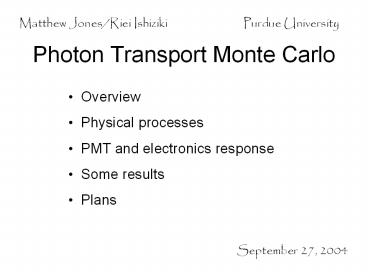Photon%20Transport%20Monte%20Carlo - PowerPoint PPT Presentation
Title:
Photon%20Transport%20Monte%20Carlo
Description:
Matthew Jones/Riei Ishiziki Purdue University Photon Transport Monte Carlo Overview Physical processes PMT and electronics response Some results Plans – PowerPoint PPT presentation
Number of Views:232
Avg rating:3.0/5.0
Title: Photon%20Transport%20Monte%20Carlo
1
Photon Transport Monte Carlo
Matthew Jones/Riei Ishiziki
Purdue University
- Overview
- Physical processes
- PMT and electronics response
- Some results
- Plans
September 27, 2004
2
Overview
- A photon transport Monte Carlo was developed to
interpret TOF results from Run-Ic. - This developed into the current photon transport
code. - Current incarnation of Photran is in the
repository
3
Physical Processes
- Photon propagation
- Dispersion effects
- Bulk attenuation
- Scattering
4
Physical Processes
- Material boundaries
- Transmission with refraction
- Reflection
- Internal reflection
- Material interfaces
- White paper iterative scattering/reflection
- Black paper reflection/absorption
- Black tape absorption
- Air reflection/refraction
5
Geometry Primitives
- Bounded surfaces
- Rectangle, triangle, circle, annulus,
- Numerical description of more complex surfaces
(eg, curved surface of Winston cone) - Volumes (regions bounded by surfaces)
- Box, prism, lens, disc,
- Winston cone
- Materials (volumes physical properties)
- Scintillator, Lucite, BC634A, Borosilicate
- Aluminum, air,
6
TOF Geometry
- Description of a bar with PMTs at both ends in
their aluminum housings
Scintillator PMT Aluminum housing
7
Response to radiation
- Scintillation
- Energy loss in material
- Scintillation efficiency
- Spectrum of emitted light
- Cherenkov emission
- Useful for some studies
- Usually overwhelmed by scintillation process
8
Photon Transport Problem
- Given an incident charged particle
- Calculate the energy loss
- Photons are created along its path
- Photons propagate throughout the system
- Record the times at which they hit the
photocathodes of any PMTs in the system
9
Simulation of PMT
- Parameterizations for
- Wavelength dependent quantum efficiency
- Anode response (Polya distribution)
- Transit time
- Pulse shape
- TTS
10
Simulation of Base
- Two pole impulse response (Note 5358)
- Convolution with Gaussian PMT response
- Preamp adds additional small contribution to
pulse width - Not simulating gain switching in preamp
- Not explicitly simulating dispersion in cable
11
Front-end Electronics
- Fast components go to discriminator.
- Slow components used to measure charge.
High pass filter
Low pass filter
12
Resulting pulses
East
West
Discriminator threshold is assumed to be 1 unit.
13
Timing Resolution
- Without any tuning,
- Current limitations
- Poisson photon statistics, not Landau
- Constant gain conversion not simulating primary
photoelectron statistics (Polya distribution)
14
Time difference analysis
- 2 GeV muons (MIPs)
- Normal incidence
- Plot residuals to linear fit
- Speed of light is s 15 cm/ns
- Agrees with results from calibration
s14-15 cm/ns
West East
Time difference vs z
15
Time difference analysis
- 2 GeV muons (MIPs)
- Typical angular distribution R140 cm,
?z30 cm - Larger nonlinear systematic variation with z
West East
Time difference vs z
16
Comparison with data
Channel 0, store 3699
- Qualitative comparison limited by resolution
- The scale of the effect is about right
- Need to study dependence on discriminator
threshold
17
Some current issues
- Need to validate response of front-end
electronics to quantify discriminator thresholds - PMT and base should be fine (Note 5358)
- Preamp has Z 100 ohms
- Preamp gain is about 15 (small signals)
- Havent checked preamp shaping recently
- Need to check front-end electronics response
needs pulser, test stand and oscilloscope - Still wont have exact prediction for npe for a
MIP - Need to parameterize gated charge integration
18
Ongoing studies
- For identical particle configurations (particle
type, entrance point, entrance angle, momentum),
all information is contained in the shape of the
leading edge of the discriminator pulse and the
integrated charge. - Most studies involve measuring time slewing
function for different particle configurations.
19
Ongoing studies
- Slewing correction function for central muons
compare qualitative behavior with calibration
results, artificially enhanced/degrade light
output. - Slewing corrections for slow particles normal
incidence, artificially restricted light output. - Slewing corrections for corner clippers.
- Slewing corrections as a function of angle look
for critical angle effects.
20
Conclusions
- Photran package works well enough for most
studies of immediate interest - Current studies expected to be good modulo
absolute measure of pulse height - Plan is to relate ratios of calculated quantities
to ratios of measured quantites in data































